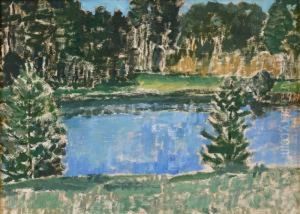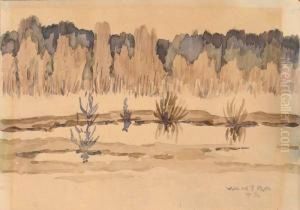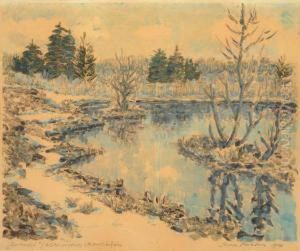Jaan Vahtra Paintings
Jaan Vahtra was an Estonian painter, graphic artist, and art teacher, known for his significant contributions to the development of Estonian modernist art, particularly in the early 20th century. He was born on April 23, 1882, in Holstre, Viljandimaa, in what was then the Governorate of Livonia, a part of the Russian Empire. Vahtra grew up in a time of national awakening for Estonia, and this sense of national identity had a profound impact on his artistic direction.
After initial studies at the St. Petersburg Art and Industry Academy (today known as Stieglitz Academy), he went on to further his education in art at the Dresden Academy of Fine Arts in Germany. Vahtra's style was significantly influenced by the European avant-garde movements of the time, including Cubism and Expressionism, but he also drew inspiration from traditional Estonian folk art.
Vahtra was a member of the influential Estonian artists’ group known as the 'Pallas Art Society' (Pallas Kunstiselts), which he joined in 1918. This society was instrumental in promoting modernist art in Estonia. Vahtra's art often featured geometric simplicity, and he was one of the first Estonian artists to incorporate elements of abstraction into his work. Alongside his paintings, he was also known for his graphic designs, book illustrations, and typographic work, which showcased his range and versatility as an artist.
During the interwar period, Vahtra was actively involved in teaching, passing on his knowledge and avant-garde ideas to a younger generation of Estonian artists. He taught at the Pallas Art School in Tartu, which was a major center for the arts in Estonia at the time.
Jaan Vahtra's contribution to Estonian art was not limited to his own creative work. He was also deeply involved in the art community as an organizer and advocate for modern art movements. His work was exhibited widely in Estonia and abroad, and he played a crucial role in establishing the Tartu Art Museum in 1940, which remains an important cultural institution in Estonia today.
Vahtra's career was cut short by the turmoil of World War II and the subsequent Soviet occupation of Estonia. He continued to work under these difficult circumstances but faced restrictions on his artistic freedom. Jaan Vahtra passed away on February 17, 1947, in Tallinn, Estonia. Despite the challenges of his time, Vahtra's legacy endures through his art and the influence he had on the generations of Estonian artists who followed him.


